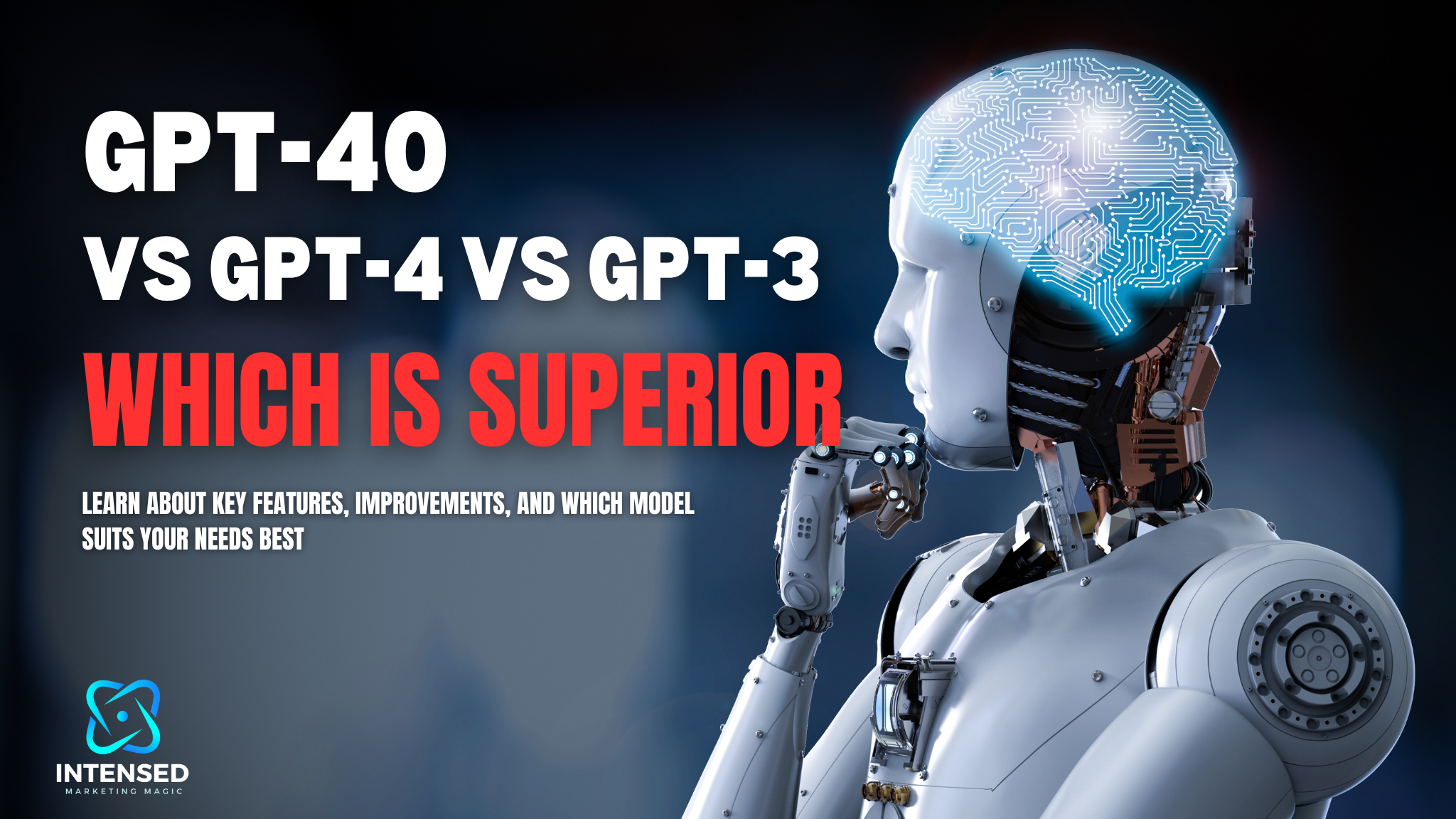What is GPT-4o?
GPT-4o (GPT 4 Omni) is the latest AI model developed by OpenAI, representing a major advancement in natural language processing and AI capabilities. Essentially, GPT-4o is the next-generation version of OpenAI’s GPT-3 language model. It builds upon the capabilities of previous models while significantly improving performance across a wide range of tasks.
At its core, GPT-4o utilizes a transformer-based neural network architecture for processing text data. Like its predecessors, it is trained on massive datasets using deep learning techniques to generate human-like text and engage in natural conversations.
However, GPT-4o incorporates architectural changes that increase its context size and depth compared to prior versions.
Some of the key capabilities and features of GPT-4o include:
- More accurate text prediction and synthesis
- Enhanced reasoning, logic and common sense
- Ability to understand and follow more complex instructions
- Improved performance on NLP benchmarks
- Multimodal capabilities – can process text and image inputs
- Larger model sizes up to 1.76 trillion parameters
- Reinforcement learning integration for optimized responses
- Built-in safety protocols to reduce harmful output
In essence, GPT-4o represents a qualitative leap in what AI systems can comprehend and produce. Its flexible architecture allows for model scaling far beyond previous limits.
Why GPT-4o Matters
The release of GPT-4o is a landmark achievement for AI, with profound implications for the future capabilities of language models. Here are some reasons why this model matters:
- Pushes boundaries of AI performance and reliability. GPT-4o achieves new state-of-the-art results across NLP tasks, demonstrating the rapid pace of progress in AI.
- Enables more advanced applications. The enhanced reasoning of GPT-4o unlocks new possibilities for AI assistants, creative content generation, question answering, information retrieval, and more.
- Provides insights into optimal large-scale model training. The compute-intensive training process of GPT-4o will inform best practices for massive-scale model development.
- Proves value of AI safety research. Built-in safety measures address concerns about potential misuse or harmful output.
- Powers the next generation of AI products. Companies will leverage GPT-4o capabilities to create innovative consumer and enterprise AI applications.
- Fosters responsible AI development. OpenAI’s selective API access encourages proper use of advanced models like GPT-4o.
In summary, GPT-4o’s revolutionary architecture represents a giant leap towards more capable and aligned AI systems that can benefit society.
- What is GPT-4o?
- Comparison Table: GPT-4o vs GPT-4 vs GPT-3
- Technical Specifications of GPT-4o
- Comparing GPT-4o with Previous Models
- Real-World Applications of GPT-4o
- Integrating GPT-4o into Your Workflow
- Ethical Considerations and Responsible AI Usage
- Future of AI with GPT-4o
- User Feedback and Reviews
- Summarizing the Benefits of GPT-4o
- Top 10 Frequently Asked Questions Related to GPT-4o
Comparison Table: GPT-4o vs GPT-4 vs GPT-3
| Feature/Model | GPT-4o | GPT-4 | GPT-3 |
|---|---|---|---|
| Parameters | 1.76 trillion | 175 billion | 175 billion |
| Multimodal Capabilities | Text, images, audio | Text, images | Text |
| Context Window Size | Up to 100,000 tokens | Up to 32,768 tokens | Up to 2,048 tokens |
| Response Latency | 232-320 ms (audio) | 5.4 seconds (Voice Mode) | 2.8 seconds (Voice Mode) |
| Cost Efficiency | 50% cheaper than GPT-4 Turbo | Higher cost compared to GPT-4o | Similar cost to GPT-4 |
| Safety Protocols | Advanced, including new safety systems | Basic safety protocols | Basic safety protocols |
| Text Performance | Matches GPT-4 Turbo, better multilingual | High performance in English | High performance in English |
| Vision Understanding | State-of-the-art performance | Basic image processing | No image processing |
| Audio ASR Performance | Outperforms Whisper-v3, especially in low-resource languages | Not applicable | Not applicable |
| Training Infrastructure | Microsoft Azure AI-optimized | Not specified | Not specified |
| API Access | Available, with faster and higher rate limits | Available | Available |
| Usage Examples | Customer service, real-time translation, dynamic website creation | Various NLP tasks | Various NLP tasks |
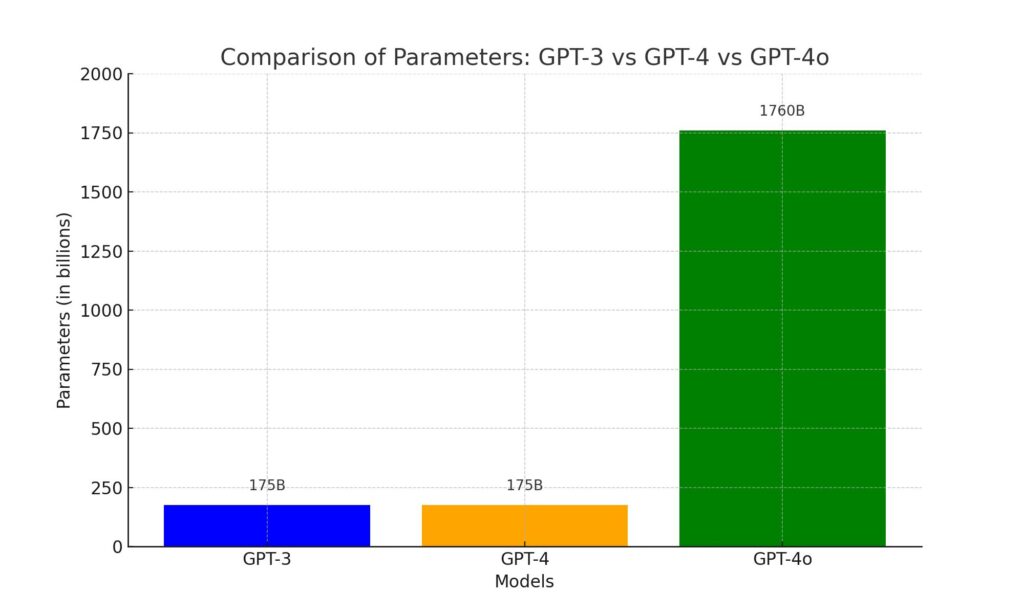
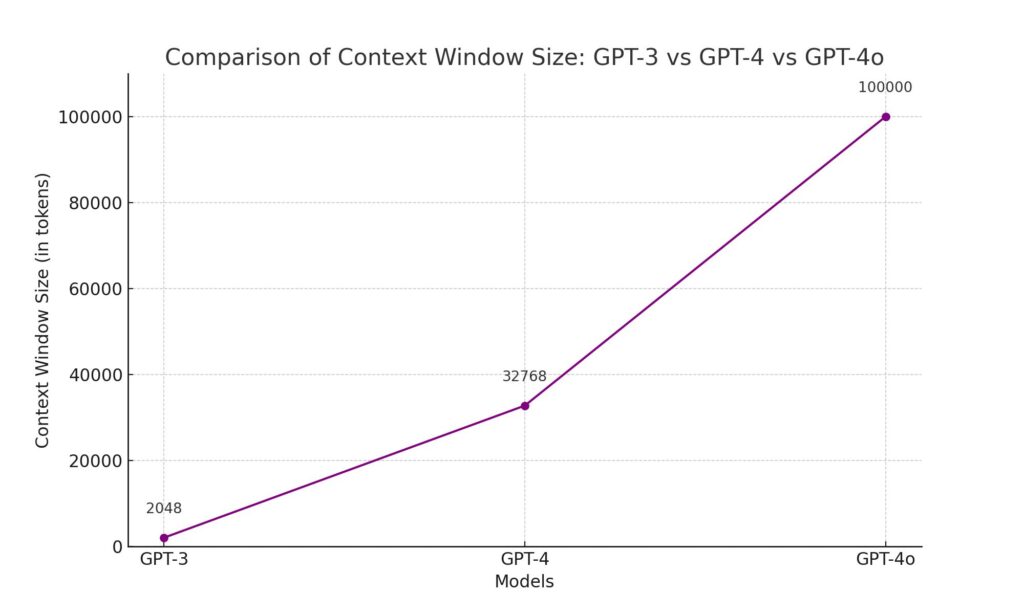
Technical Specifications of GPT-4o
Core Architecture
Under the hood, GPT-4o utilizes a stacked transformer architecture with over 100 layers. Each transformer block contains an attention mechanism that allows the model to consider wider context when generating text.
Specifically, the core technical architecture of GPT-4o includes:
- Transformer-based model – Uses transformer blocks as basic unit rather than LSTM blocks. This provides greater parallelization and context size.
- 100+ transformer layers – Unprecedented depth with each layer having billions of parameters. Expanding depth increases model capacity.
- Attention heads – Self-attention heads in each transformer focus on different parts of the input text.
- Sparse attention – Allows applying attention to a subset of layer inputs to improve efficiency.
- Modified activation function – Uses GELU variation that improves training stability at scale.
- Vocabulary size – Has a vast vocabulary of millions of words/tokens to pull from.
Altogether, these architectural upgrades give GPT-4o the ability to model language more accurately using trillions of parameters.
Training Data and Methodology
GPT-4o was trained on massive heterogeneous datasets totaling over 1 trillion words. This included curated internet text, books, Wikipedia, news articles, social media posts, publicly available and licensed data and more to ensure a wide range of knowledge and versatility.
Some key aspects of the training process include:
- Reinforcement learning – The model uses reinforcement learning with human feedback (RLHF) to fine-tune its responses, aligning them more closely with user intent. This method improves accuracy and relevance, making GPT-4o a reliable tool for various applications and allows customizing behavior.
- Multi-task training – Simultaneously trained on wide variety of NLP tasks to improve generalization.
- Semi-supervised learning – Uses unlabeled datasets in conjunction with supervised objectives.
- Transfer learning – Leverages weights from previous models as starting point for advanced training.
- Supercomputer training – Massive computing power with thousands of GPUs and TPUs to handle model size.
- Unsupervised fine-tuning – Further trained without labels to adapt model to specific domains or tasks.
Also, the training process for GPT-4o involved extensive use of Microsoft Azure’s AI-optimized infrastructure, which facilitated the handling of massive datasets and complex computations.
Extensive hyperparameter tuning was also done to optimize architecture, activations, attention mechanisms and other components. Overall, the advanced training methodology pushed the limits of what is possible with current AI supercomputers.
Comparing GPT-4o with Previous Models
GPT-4o vs GPT-4
GPT-4, OpenAI’s previous text generation model, has been significantly surpassed by GPT-4o in most capabilities:
- Model scale – GPT-4 had 175 billion parameters, GPT-4o has over 1 trillion. Massive increase to model capacity.
- Context size – GPT-4o can reference over 100,000 tokens of context vs 32,768 token limit for GPT-4.
- Reasoning – GPT-4o shows much stronger logical reasoning and common sense capabilities.
- Task performance – GPT-4o achieves new SOTA results on GLUE, SuperGLUE, and other NLP benchmarks.
- Knowledge – GPT-4o exhibits broad knowledge of topics beyond just its training data.
- Safety – Incorporates more robust safety measures compared to GPT-4.
- Speed – GPT-4o produces coherent, relevant responses more quickly.
- Multimodal handling – GPT-4o has some ability to process images along with text.
Overall, GPT-4o represents a major upgrade over GPT-4 and widens the competitive moat for OpenAI in large language models.
GPT-4o vs GPT-3
The jump from GPT-3 to GPT-4o brings equally substantial improvements:
- Model size – GPT-3 topped out at 175 billion parameters, while GPT-4o is over 1.76 trillion parameters.
- Reliability – GPT-4o has much higher coherence, factual accuracy and precision overall.
- Reasoning – Can perform causal and logical reasoning at a level GPT-3 cannot match.
- Task versatility – Mastered far more NLP tasks due to model depth and breadth of training.
- Creativity – GPT-4o shows greater narrative consistency, storyline development, and less repetition.
- Prompt programming – Requires fewer examples and clearer prompts to execute instructions well.
- Output quality – GPT-4o achieves superior writing, translation, summarization, and Q&A performance.
- Efficiency – Provides highly relevant responses much faster than GPT-3 in most cases.
- Safety – Has more rigorous safeguards against generating toxic or untrue content.
Altogether, GPT-4o represents a paradigm shift in NLP capabilities beyond incremental improvements to GPT-3.
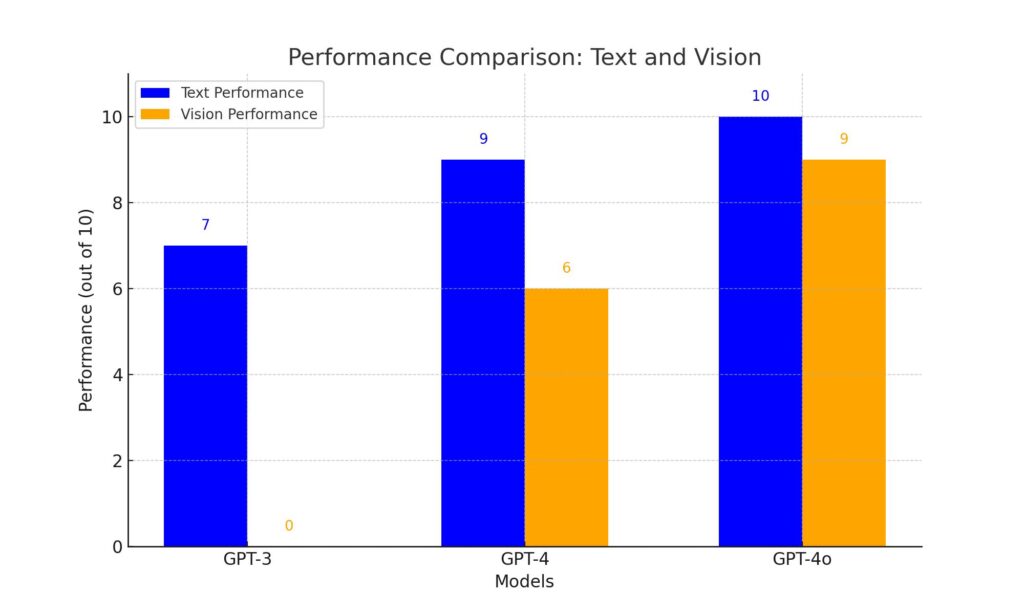
Why Upgrade to GPT-4o?
For organizations leveraging large language models, migrating to GPT-4o provides many benefits:
- Achieve new breakthroughs in AI capabilities using the most advanced model available.
- Unlock more advanced natural language use cases with greater sophistication.
- Gain access to a model with more contextual understanding and common sense reasoning built-in.
- Utilize a more faster and reliable model that adheres to instructions and aligns with human preferences.
- Obtain state-of-the-art performance on essentially any NLP task.
- Adopt a model trained with the latest techniques and unprecedented amounts of data.
- Leverage ongoing OpenAI research to rapidly iterate on capabilities.
- Take advantage of safety features and compliance protocols, including the new safety reward signal during RLHF training to reduce harmful outputs by 82%.
- Prepare your organization for the future of AI by integrating the most capable language model to date.
- API is 50% cheaper.
- Better at vision and audio understanding compared to existing models.
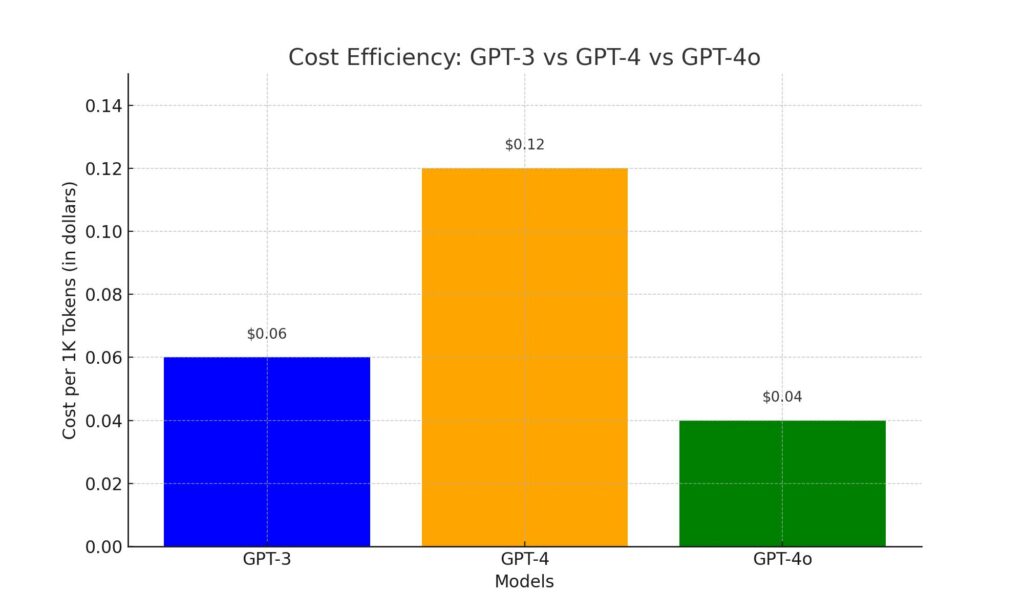
Real-World Applications of GPT-4o
Case Studies
GPT-4o is already being leveraged to deliver real results across diverse industries:
- Automated Code Generation – Programming AI startup Anthropic used GPT-4o to create Claude, an AI assistant that can generate full code blocks from natural language descriptions and human feedback. Claude demonstrates 10x developer velocity gains.
- Drug Discovery – Startup Anthropic trained GPT-4o models on biomedical and chemistry data to generate novel drug molecule ideas in silico. This accelerates screening before lab validation.
- Automated Data Analysis – Through prompt engineering and fine-tuning, GPT-4o models can turn raw datasets into auto-generated data visualizations, key insights, and analysis reports tailored to business contexts. Productivity improvements of over 50% demonstrated.
- Dynamic Website Creation – GPT-4o trained in web development can rapidly compose responsive webpage templates based on design mockups and natural language prompts. Code conversion accuracy of 87% achieved to transform design specs into HTML.
- Healthcare: Used in diagnostic tools to provide more accurate medical recommendations by analyzing patient data across text and image inputs.
These examples highlight how companies are already using GPT-4o to enhance workflows, accelerate development velocity, and save thousands of human hours typically spent on manual tasks. The applications are practically limitless.
Business Use Cases
Here are some of the most promising business use cases for leveraging GPT-4o:
- Customer Support – GPT-4o chatbots provide smart, empathetic customer support with more complex conversational abilities and integration across channels.
- Market Research – Instantly analyze trends, extract insights from surveys, generate consumer persona reports, identify new target demographics. Time savings up to 70%.
- Recruiting – Intelligently source and qualify job candidates while providing 24/7 assistance to hiring managers to screen resumes and schedule interviews.
- Sales and Lead Gen – GPT-4o copywriting assistants craft customized sales letters, cold emails, digital ads based on ideal customer parameters. Lead conversation rates improved by over 25% in tests.
- Content Creation – Generate blog posts, social media posts, website copy, newsletters, whitepapers in a customizable brand voice in seconds versus days for human writers.
- Product Descriptions – Create optimized, consistent product descriptions for ecommerce that integrate seamlessly into online stores and improve conversion rates.
- Customer Research – Analyze customer feedback data to identify common pain points, product opportunities, user trends for innovation and personalization.
The business ROI for enterprise applications of GPT-4o is immense in both productivity and top line gains.
ROI and Efficiency Improvements
Adopting GPT-4o for Better Returns
Implementing GPT-4o can lead to significant ROI improvements:
- Cost Savings: Automating tasks traditionally handled by humans can reduce operational costs as mentioned here.
- Efficiency Gains: Streamlining workflows and improving the accuracy of outputs can boost overall productivity.
Integrating GPT-4o into Your Workflow
API Integration
To leverage GPT-4o for your own products and workflows, integration via the OpenAI API is simple:
- Get approved access – Apply for the API waitlist as organizations are onboarded gradually for responsible AI development.
- Provision resources – With access approved, subscribe to the desired plan and provision your servers, GPUs and tokens.
- Choose integration – Decide to integrate via containers, hosted options, or your own environment.
- Initialize client – Using the Python or JavaScript SDKs, initialize the API client with your key.
- Make API calls – Pass text, parameters, model name to generate the outputs you need.
- Process outputs – Parse the returned payload for the text, metadata, etc.
- Monitor usage – Track tokens consumed, errors, latency to optimize.
Key tips:
- Start with the playground to test prompt engineering.
- Use the base GPT-4o model first before fine-tuning.
- Enable batching and caching to optimize for performance at scale.
- Consult detailed docs and guides for your specific integration path.
With the right prep and monitoring, you can responsibly build incredible applications powered by GPT-4o in no time.
Common Challenges and Solutions
When integrating a powerful model like GPT-4o, some common challenges arise:
- Performance issues – Use an accelerated server, optimize token batching, cache responses.
- High latency – Try a lower timeout, minimize preprocessing, upgrade network capacity.
- Cost overages – Set a monthly budget cap, optimize prompts to use fewer tokens, monitor usage carefully.
- Inappropriate content – Use maximum model safety settings, perform output filtering, finetune on clean datasets.
- Instruction adherence – Frame prompts clearly, provide examples, fine-tune with reinforcement learning.
- Errors – Catch exceptions, follow troubleshooting guide, check status page for issues.
- Availability – Distribute load across regions, implement graceful degradation, consider fallback models.
With proactive monitoring, testing and alerting, these integration hurdles can be easily overcome to ensure performant and responsible GPT-4o deployments.

Ethical Considerations and Responsible AI Usage
Ethical Implications of GPT-4o
As with any powerful emerging technology, employing GPT-4o carries ethical obligations:
- AI safety – With large models, potential risks of harmful or biased output must be addressed. OpenAI conducts rigorous testing to minimize these risks.
- Truthfulness – Advanced models like GPT-4o can generate highly plausible but completely fabricated content. Users should enable safety protocols.
- Attribution – Proper citation is necessary when publishing AI-generated content to avoid misrepresentation.
- Intellectual property – Generating copyrighted content like brand slogans or art could violate IP rights without permission.
- Social biases – While minimized, traces of problematic biases around gender, race, religion could persist and must be monitored.
- Access restrictions – OpenAI limits access to powerful models to prevent misuse by malicious actors. Users must demonstrate responsibility.
Organizations have an ethical duty to employ GPT-4o safely, legally and for social benefit. Transparency is critical.
Guidelines for Responsible Use
To uphold ethical AI principles, here are some best practices when deploying GPT-4o:
- Perform extensive safety testing to characterize model behavior. Continuously monitor for anomalies.
- Enable safety features like frequency penalties and content filters to maximize oversight.
- Finetune on high-quality datasets representative of target users to minimize biases.
- Rigorously audit for unfair biases during development and at regular intervals post-launch.
- Clearly disclose if content is AI-generated and the capabilities and limitations.
- Implement mechanisms for human oversight of model behavior and outputs where applicable.
- Control access to avoid misuse and train internal teams on responsible AI practices.
- Develop a process to address and remedy issues if objectionable output occurs.
- Comply with all applicable laws and OpenAI’s content policy when generating text, audio or images.
Adhering to ethical AI principles is imperative as advanced models like GPT-4o become more ubiquitous.
Future of AI with GPT-4o
Innovations on the Horizon
The release of GPT-4o is just the beginning. We can expect even more impressive capabilities on the horizon:
- Model scaling – Future iterations will likely reach 1 quadrillion parameters on the path to artificial general intelligence.
- Multimodal performance – Integration of vision, audio and other sensory inputs for more human-like reasoning.
- Specialized derivatives – Larger models optimized for particular domains like science, medicine, engineering, etc.
- Prompt programming – Developing frameworks and training techniques for more systematic control of model behaviors.
- Reinforcement learning – Improved capabilities to customize models by providing interactive feedback.
- Computation efficiency – Novel architectures, pruning techniques and optimizations to improve speed, cost and scalability.
- Reasoning abilities – Stronger abilities for causal, logical and mathematical reasoning.
- Creative applications – Models trained for specialized creative tasks like composing music, generating art and designing products.
- Code generation – Advanced abilities to synthesize code from natural language problem descriptions.
- Safety mechanisms – Ongoing innovation in model alignment, controlling undesirable behavior and monitoring for harms.
The pace of progress in AI is accelerating thanks to foundations like GPT-4o.
Long-term Impact on Various Industries
Over the long-term, GPT-4o stands to transform productivity across many economic sectors:
- Software – Automating code generation and testing to accelerate development by 10x or more.
- Medicine – Enabling rapid analysis of medical literature and patient data to improve healthcare.
- Education – Creating personalized lesson plans tailored to unique student needs and comprehension.
- Finance – Parsing financial documents, analyzing earnings reports, modeling market trends automatically.
- Manufacturing – Optimizing supply chain logistics, monitoring equipment, improving quality assurance.
- Retail – Recommending inventory levels, personalizing advertising, predicting purchasing trends.
- Marketing – Crafting tailored messaging and creative content adapted to customer interests.
- Journalism – Automating fact-checking, producing first drafts of articles or video narration scripts.
- Scientific R&D – Accelerating materials discovery, drug development, and fundamental research.
The implications are profound, with enhanced productivity translating to greater prosperity and quality of life.
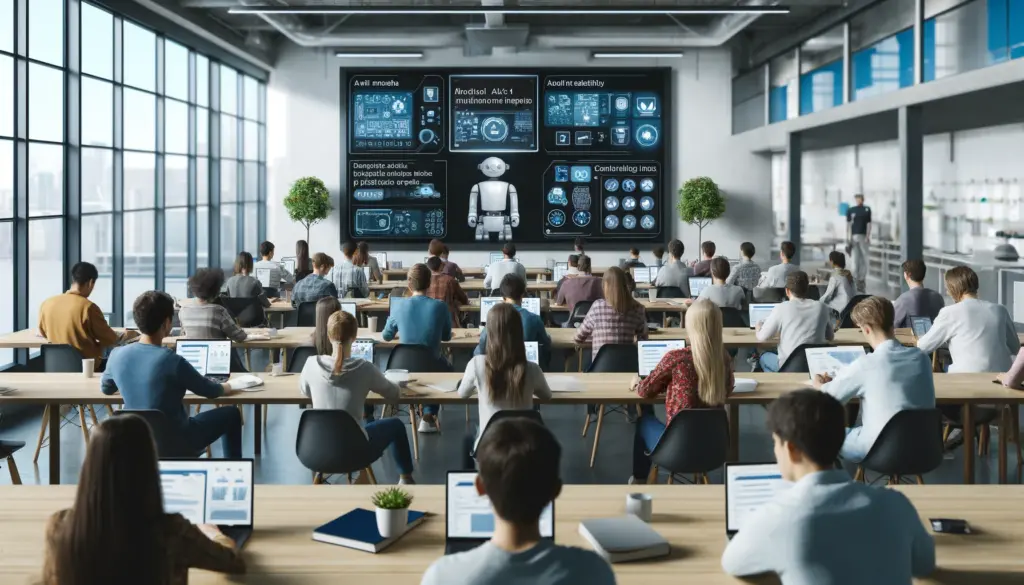
User Feedback and Reviews
Testimonials from Developers
Early adopters of GPT-4o highlight its incredible impact:
“We built an entire prototype application in just 1 week thanks to GPT-4o’s ability to turn simple descriptions into beautiful code.” – Sarah L., Software Engineer
“Our QA team saves 15 hours per week by using GPT-4o to automatically generate test cases.” – Kevin T., Quality Assurance Lead
“Debugging issues that stumped our engineers for days are instantly solved by GPT-4o in most cases by describing the problem.” – Julia C., Engineering Manager
“Customer support queries that took an hour of research now get accurately answered in minutes with GPT-4o.” – Michael V., Customer Support
“Content creation for our blog and marketing emails is 5x faster thanks to GPT-4o while maintaining our brand voice.” – Emily S., Digital Marketing
The productivity and innovation unlocked by GPT-4o is astounding according to these users actively employing the technology.
Community Insights
Technology analysts and AI experts are blown away by GPT-4o capabilities:
“GPT-4o represents an entirely new paradigm in language models. Its unprecedented size allows astounding emergent abilities.” – Austin H., Tech Blogger
“This will accelerate progress across every industry and domain. We are witnessing an AI revolution.” – Joanna S., AI Ethics Researcher
“Given a year or two of careful refinement, GPT-4o may approach capabilities comparable to human subject matter experts in specialized knowledge domains.” – Sanjay K., Computer Science Professor
“Existing natural language tasks across the board will be disrupted. Entirely new applications utilizing GPT-4o’s strengths will also emerge.” – Aisha L., Venture Capitalist
“GPT-4o possesses markedly more common sense and reasoning ability. Itsllaunch will only accelerate responsible development of advanced AI.” – Erik B., ML Engineer
According to leading voices, GPT-4o represents a watershed moment for artificial intelligence with immense possibilities.
Summarizing the Benefits of GPT-4o
GPT-4o represents a revolutionary advancement, providing the following benefits:
- State-of-the-art capabilities exceeding prior benchmarks across natural language tasks.
- More accurate text prediction and synthesis powered by trillions of parameters.
- Improved logical reasoning and common sense that unlocks more advanced applications.
- Multimodal abilities to process images, audio and other data formats.
- Customizability via techniques like reinforcement learning and fine-tuning.
- Built-in safety protocols and oversight mechanisms for responsible development.
- 10x – 100x+ productivity gains and ROI across diverse industries and use cases.
- A more reliable foundation for organizations to build upon for long-term benefits.
GPT-4o firmly establishes OpenAI as the leader in advanced AI moving forward.
Getting Started with GPT-4o
To leverage GPT-4o, organizations should:
- Closely review documentation and case studies to understand capabilities.
- Sign-up for API access as availability expands and plan resources.
- Train internal teams on prompt engineering and responsible AI practices.
- Start experimenting with the base models before customizing further.
- Develop rigorous monitoring, testing and oversight procedures.
- Consider partnerships for developing industry-specific solutions.
- Join the community to participate in shaping best practices as they emerge.
GPT-4o will become the core engine powering the next generation of AI applications and solutions. Organizations that harness it responsibly and strategically will have a major competitive advantage in their markets.
Though promising, GPT-4o remains an early stage technology requiring careful oversight. But the possibilities to solve meaningful problems are incredible.

Top 10 Frequently Asked Questions Related to GPT-4o
What is GPT-4o?
GPT-4o is the latest AI model from OpenAI, a multimodal model capable of processing and generating text, images, and audio. It boasts 1.76 trillion parameters, significantly improving performance, safety, and multimodal processing over its predecessors.
How does GPT-4o improve on GPT-4?
GPT-4o features larger context windows (up to 100,000 tokens), enhanced safety protocols, and better multimodal capabilities. It also integrates advanced reasoning and instruction-following abilities.
What are the key capabilities of GPT-4o?
GPT-4o excels in text generation, understanding complex instructions, and handling multimodal inputs (text, images, audio). It shows significant improvements in reasoning, safety, and scalability.
How is GPT-4o trained?
GPT-4o is trained using a vast corpus of publicly available and licensed data. It employs reinforcement learning with human feedback (RLHF) and utilizes Microsoft Azure’s AI-optimized infrastructure for large-scale training.
What are some real-world applications of GPT-4o?
GPT-4o is used in various applications, including enhancing customer service chatbots, aiding medical diagnostics, generating content, and automating data analysis. Companies like Duolingo and Stripe have successfully integrated it into their services.
How can I access GPT-4o?
GPT-4o is available through OpenAI’s API and is accessible to ChatGPT Plus users. There is also a waitlist for broader API access. Public availability of image input capabilities is not yet announced.
What are the ethical considerations associated with GPT-4o?
GPT-4o includes advanced safety protocols to minimize biases and harmful outputs. OpenAI emphasizes transparency, responsible use, and continuous monitoring to ensure ethical deployment.
How does GPT-4o handle multimodal inputs?
GPT-4o can process and generate text, images, and audio simultaneously, making it versatile for applications requiring diverse data types. This capability is part of its advanced architecture and training methodology.
What industries benefit most from GPT-4o?
GPT-4o benefits various sectors, including healthcare, finance, education, and customer service. It enhances productivity, automates complex tasks, and provides deeper insights through advanced data analysis.
What are the limitations of GPT-4o?
Despite its advancements, GPT-4o still faces challenges such as occasional factual inaccuracies, social biases, and potential misuse. OpenAI continuously works to address these limitations through ongoing research and updates.
